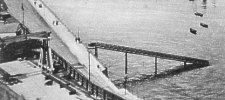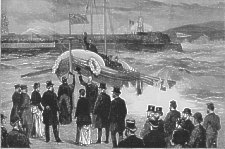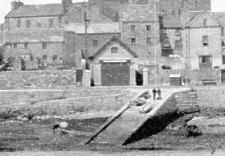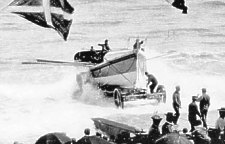
Douglas lifeboat house & ramp c. 1897
The founder of what became the RNLI was Sir William Hillary, descended from a Yorkshire Quaker family, who for a mixture of reasons, mostly financial but also an irregular matrimonial arrangement, came to live in Douglas. In 1823 he published a pamphlet 'An Appeal to the British Nation on the Humanity and Policy of forming a National Institution for the Preservation of Lives and Property from Shipwreck'. He also personally took part in many rescues of stranded ships. A lasting legacy to Douglas is the Tower of Refuge and he lies buried in St George's churchyard.
The first boat built under the auspices of the newly formed National Institution for the Preservation of Life from Shipwreck was allocated to Douglas where it joined another boat paid for by ship insurers. Although Sir William had suggested a 40 ft steam driven boat, cork-lined for buoyancy, economics dictated a 24 ft row boat with 8 double banked oars.
During the 1820's committees were established in Douglas, Castletown, Peel and Ramsey to establish lifeboat stations; however both these and the UK Institution went into decline during Sir William's final, poverty stricken years before his death in 1847. The UK Institution did not recover its vigour until around 1851 - stations were re-established on the Island from the 1850's with Port St Mary being the last. In 1918 the Institution decided to replace all their row-boats with motor boats - these required different accommodation and support thus as they were introduced to the Island from the 1920's some stations needed to be rebuilt.
Although local residents raised some money for a boat to replace the original lifeboat, declared to be unserviceable in 1851 and the Institution offered support in 1855 to refound the station, nothing happened until 1867, when, following the offer of a privately funded lifeboat, High Bailiff Samuel Harris paid for the construction of a boathouse on the Promenade close by the Iron Pier. Although the offer of a new boat was later withdrawn, a new boat was presented in 1868 named 'Manchester and Salford Sunday Schools' as it was paid for by collections from that source.
By the 1890's the boathouse had become an impediment to improving and widening the Promenade to cater for the immensely important tourist trade. A new site was chosen within the harbour in 1891/2 (dates differ between sources) and in 1895 Douglas Town Commissioners purchased the old boathouse, widened the road, and built a new public shelter.

Douglas lifeboat house & ramp c. 1897
A building at the foot of Battery Pier had been constructed in 1886 to house the second boat the John Turner-Turner. In 1887 a new No. 1 boat, Civil Service No. 6 replaced the original but in 1895 this was damaged by the IoMSPCo Peveril during a gale and had to be replaced in 1896 by a new boat (though with same name). The new boathouse was built close by in the Habour Commissioners' yard using rollers to cross the road and a steel slipway built to take the boat into deep water. The first motor boat boat Manchester and Salford entered service in 1924 and remained until after WW2. A new boathouse and slipway on the habour side of the road from the 1895 house was built to receive the new boat.
Although a station was built in 1828 during the initial enthusiastic years, the boat (a locally built replacement for the wrecked original) was noted as unserviceable by 1843. Local indifference (or, more likely, concern as to how to find maintenance costs) delayed the re-establishment of a new station until 1884. A boathouse was then built beneath the Castle walls (described as being typically ecclesiastical in appearance and built from local sandstone). This house remained until extensively rebuilt in 1992.

Launch of the new Lifeboat - Graphic 24 Oct
1885
The boat sent to the newly re-established station was the John Monk, named after its benefactor Capt John Monk. (The name on the woodcut is 'Pell ..') It was this boat that was involved in the rescue of the Norwegian vessel the 'St George'; it was replaced in 1897 by the Maybew Medwin. When Port Erin received its first motor boat in 1924 the displaced Henry Kirk was transferred to Peel from 1925 where it remained until being replaced by the motor boat Helen Sutton.
Following the founding of the IoM District association of the Institution a lifeboat was stationed at Castletown from 1827 (6-oared pulling type) and the foundation stone laid for a lifeboat house below the Castle walls. However support dwindled and the station became defunct until re-established in 1856 when a new boat house was established adjacent to the courthouse and sheltering below the Castle walls in the inner harbour.
According to Blackburn the first boat was the 'Commercial Traveller No. 1'. The last boat stationed at Castletown was the 'Thomas Black' - a new boathouse had been constructed during the renovations of the Castle c.1905 on the quayside of the outer harbour (now a private dwelling) and the old house demolished.

'New' Castletown boat house
The station was closed in 1922 .
The first station was established in 1829 but like that at Peel it was no longer serviceable by 1845. A new station was established in 1868 with the arrival of the 'Two Sisters' to a new boathouse on the south shore - the Rev George Paton was for 12 years secretary and an enthusiatic supporter. The Two Sisters was officially retired in 1888 when its successor, the Mary Isabella, arrived, but this boat was not popular as it too easily shipped water and it was sent to London to be remedied, it was also larger than its predecessor and thus a new station was built to house it. The third boat, also named Mary Isabella, arrived in 1896 and was a self-righter. The fourth boat, Anna Maria Lee arrived in 1915. For some 10 years from 1892 the Two Sisters remained on the island in the Mooragh Lake.

Launch of Mary Isabella
tbc
Lifeboat station was opened in 1883 - the first boat being the 32 ft 10-oared 'Ann and Mary of Manchester' provided by a Mr Richard Roberts of Manchester. Following the request for a larger boat, it was replaced in 1892 by the 12-oared William Sugden. Some debate ensued as to whether the station should move to Port St Mary - in the end the Port Erin station remained and a new station established at Port St Mary. A new slipway was constructed around this period. The William Sugden remained in service until 1912 when it was replaced by the Henry Kirk.
Opened in 1896 - first boat was the James Stevens No. 1 which was housed, together with carriage, in a new Boathouse. It was thought that this carriage would allow the boat to be moved by road, dragged by 8 horses, along the coast if needed. It was replaced in 1917 by the Marianne which remained in service until 1936 when it was replaced by the motor driven Sir Heath Harrison. The first post postwar boat Civil Service No. 5 , and subsequent boats, remained at mooring in the harbour and the boathouse no longer housed the boat.
LIFEBOAT OFFICIALS.
Douglas — Boat Civil Service No. 6. Coxswain — Frank
McAlarney. Hon. Secretary — Thomas Bawden.
Ramsey — Boat Mary Isabella. Coxswain — Robert Garrett.
Hon. Secretary — E. C. Kerr.
Peel — Boat John Monk. Coxswain — John Wilson. Hon
Secretary — John Corris
Castletown — Boat Hope. Coxswain — Fred. Cleator. Hon
Secretary — G. H. Quayle.
Port Erin — Boat William Sugden. Coxswain — W. Collister.
Hon. Secretary — T. Clague,
— from Examiner Annual 1897
T.E.Brown The Peel Lifeboat
R.C.Kelly & G.N.Kniveton Sir William Hillary and the Isle of Man Lifeboat Stations Douglas: Manx Experience nd [1994] (1-873120-16-8)
R Kelly For those in Peril : Life and Times of Sir William Hillary Douglas:Shearwater Press 1979 (ISBN 0-904980-27-8)
W.N.Sybold The Ramsey Lifeboats 1829-1991 Ramsey:RNLI station 1991 (ISBN 0-9517945-0-7)
L Quilliam The Lifeboats of Peel 1990
J Morris The Story of the Port Erin Lifeboat, 1983
J. Morris Douglas Lifeboats (1802-2002) [no publisher, no ISBN - possibly available from Lifeboat Enthusiasts' Society, Coventry] - 46pp well illustrated pbk]
|
|
||
|
|
||
|
Any comments, errors or omissions
gratefully received The
Editor |
||